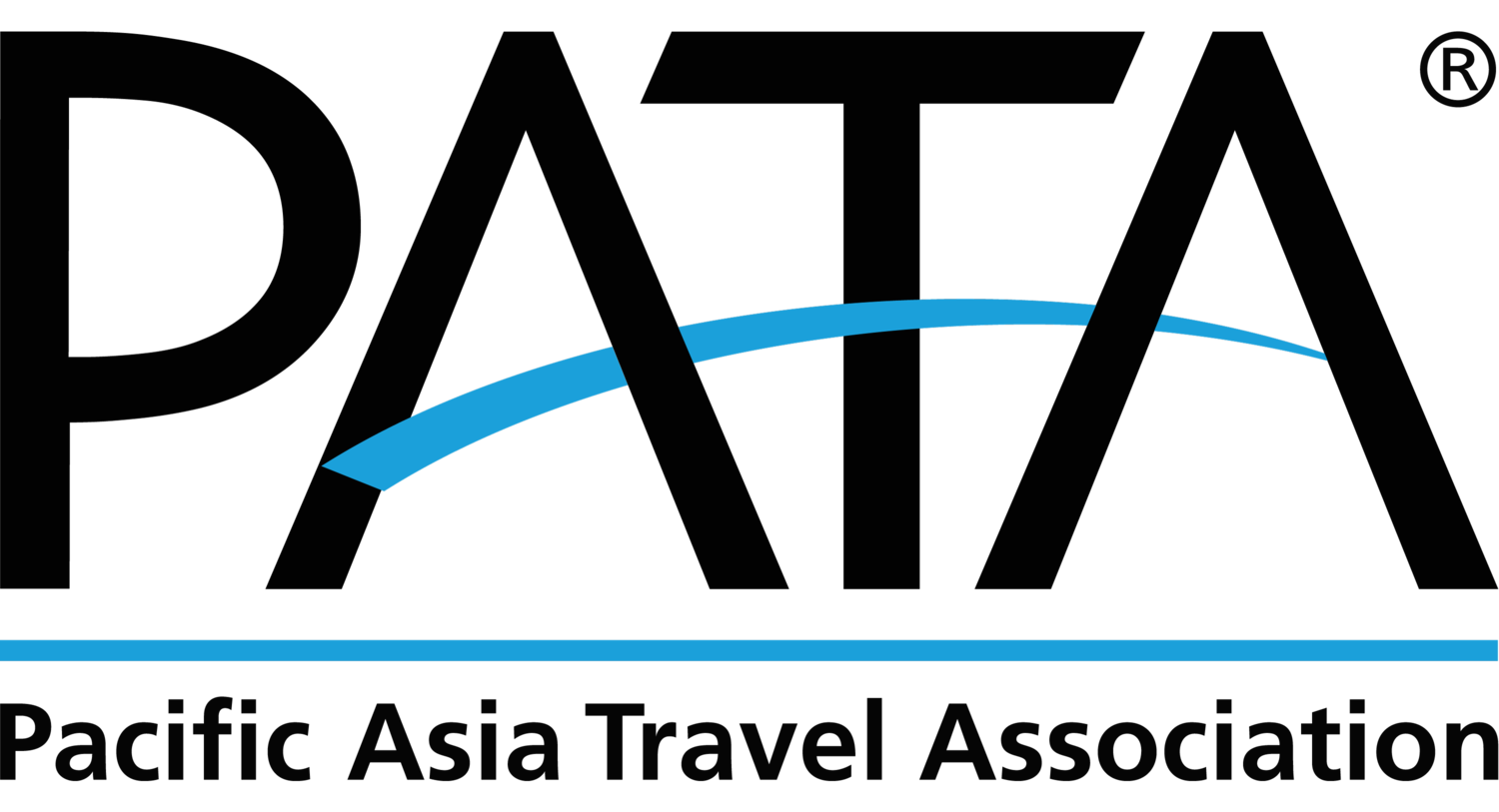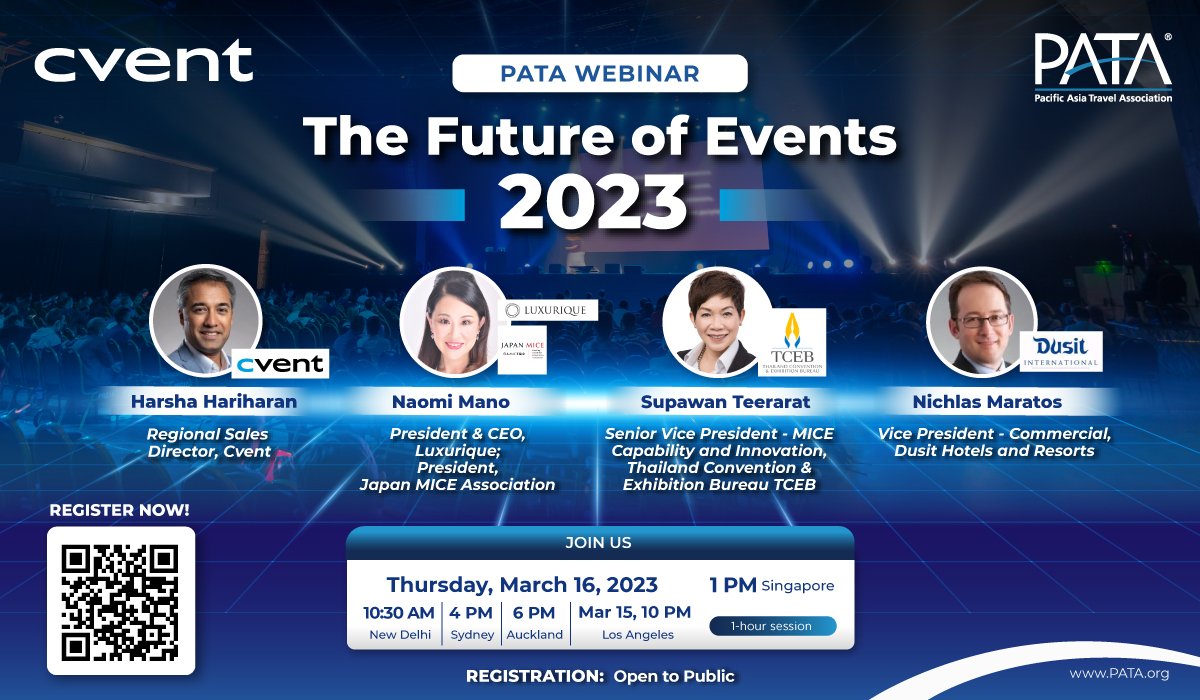The Future of Events in 2023
The global MICE industry is estimated to reach US $1,337.4 billion by 2028, and Asia Pacific is expected to see a US $441.1 billion market by 2025- a CAGR of 8.6%.
Destinations and hospitality firms need to be prepared with an action plan to capture this golden opportunity. What are the trends that stakeholders need to take note of? What does the event landscape look like with virtual, hybrid, and in-person events all in place?
In this webinar, four industry experts
Harsha Hariharan, Regional Sales Director, Cvent
Naomi Mano, President, Japan MICE Association; President & CEO, Luxurique Inc.
Supawan Teerarat, Senior Vice President - MICE Capability and Innovation, Thailand Convention & Exhibition Bureau (TCEB)
Nichlas Maratos, Vice President - Commercial, Dusit Hotels and Resorts
discuss the future trends of events and talk about the next big disruption for events that stakeholders will need to prepare for.
In the presentation by Harsha Hariharan, a survey conducted by Cvent indicated that 98% of planners in Asia will have an in-person or hybrid event in 2023, with 48% indicating plans for a virtual event. Corporate travel is also looking bright as 74% of travel managers are expecting a higher volume of business travel than 2019 in 2023, and 45% are looking at international travel. These numbers set the tone that events are indeed back and thriving.
In the panel discussion with all four speakers, three key questions were raised to understand the future of events better.
What do future events look like right now and over the next six months to a year?
What are the most innovative ways you have seen event organizers touch upon these particular trends that were already mentioned, now that events are back in full swing?
How do hotels and venues need to react to future trends?
Question 1: What do future events look like right now and over the next six months to a year?
Nichlas Maratos:
Hybrid is meeting companies’ demands well as nothing beats in-person since participants are much more focussed on the session.
Flexibility and options are the core ideas behind this trend, it has now become an expectation. Event planners need to know the options that they don't even know are options. Is it hybrid, is it dial in? How does it work and how many people do we need there in person? Does the client prefer an outdoor space where people don't feel restricted to a conference room? Flexible options and the whole tech element need to come to a different level to meet all of those are expectations. Sustainability, authentic experiences, wellness, locality; I think those are kind of under arching themes of what is coming through.
Supawan Teerarat:
A rising aspect that people are more concerned about today is sustainability in events, caring for the planet and caring for the communities. Actions taken in Thailand’s MICE industry to become carbon-neutral by 2050 include carbon reductions in all events, partnering with guest house agencies in Thailand, and applying, calculating, and promoting carbon emissions reductions to all events and to all corporates.
Another trend to consider, especially for DMOs, is authenticity at the destination– the ‘local wisdom’. Before, during, or after hosting an event, participants want to extend their stay to learn more about the destination. This goes hand-in-hand with the seen growth of “Bleisure Travel”, making it a new task for destinations to be prepared to serve them and make oneself easily accessible.
And lastly, being data-driven – both in MICE and in tourism industry.
Naomi Mano:
During COVID, one of the things that Japan has done is to provide a lot more packaged offerings.
We've also receive a lot of requests for themes related to ‘sustainability’, ‘wellness’, and ‘women in power’, as well cas events being flexible in terms of being in-person or hybrid.
Another rising trend is the search for newer event destinations that can provide an array of activities for networking and team building that are beyond meetings and conferences. This is the component that actually seems to provide a lot more weight on the choice of destination because it's not just the meeting or conference room component but more the reason for getting together.
Harsha Hariharan:
High qualities of personalisation should not be overlooked. Providers are required to differentiate their offerings through working with event partners or properties with flexible formats and offering what their clients want to do.
Opportunities are unprecedented and we are seeing things that we would never have seen two, three years ago.
It almost doesn't matter if it's virtual or hybrid or in-person; there's enough market for everybody to do something, as long as it is done better and better each year with the creativity of the venues and planners.
Question 2: What are the most innovative ways you have seen event organisers touch upon these particular trends that were already mentioned, now that events are back in full swing?
Naomi Mano:
We see our clients expressing great interest in exploring the bleisure concept– incorporating activity, team building, and also the corporate differentiators, such as the brand look and feel component, into their events.
Luxurique runs an activity called ‘The Amazing Race in Tokyo’ or ‘The Amazing Race in Kyoto’ that offers a selections of checkpoints that they want to merge with their conference. For instance, clients will use half a day from their three-day conference to conduct team building– the race, plus touring the city. They have to take photos at different venues and share those photos at the dinner event. Our clients absolutely love it since it takes every single component to create an experience, from wellness to experiencing culture to co-creating unique event elements.
Supawan Teerarat
As a government agency, TCEB is looking at and are responsible for both the demand side and the supply side. For the demand side, organisers need to select events that are truly meaningful and relevant in order to lure participants who are now very used to participate online.
At the same time, we have to support our supply chains in that ecosystem and be ready for these higher than ever expectations. In Thailand, we have been running a programme called ‘Creative Communities Based MICE’ to uplift the communities and destinations in order to be ready for MICE. TCEB works together with partners to select the communities that are not only unique but also capable to serve business events. As of now, more than 200 communities around the country are ready in terms of standardisation, cleanliness, safety, and capability to offer activities catering to preferences of our clients, such as gastronomy, history and culture, adventure, team building, CSR, luxury beach destination, and also health and wellness.
We also support a farm-to-function programme to help the supply chain be less reliant on middlemen for business, supporting the social enterprises, and in turn, supporting the community, society, and environment.
Nichlas Maratos
Dusit is now bringing the wellness and sustainability concept directly into conferences: starting one of the mornings with a sound bath and introducing the full rice programme from procurement; working with farmers to grow the rice for hotels to directly purchase, and we also take the meeting attendees into the rice farm to mingle with our pet buffalo and see the rice production.
A big part of all of this is creativity: bringing different experiences to life. Previously we had things in boxes. A sound bath was something that you did in the spa. Sustainability was something that got spoken about and it was on the annual reports, etc. Now wellness is in the meeting room and sustainability is a tea break option. There's a lot of creativity and the great thing is that the customers are driving this, pushing hotel operators to think differently and creatively to come up with unique experiences – much more than just two days in the meeting room and a gala dinner.
Question 3: How do hotels and venues need to react to future trends?
Nichlas Maratos
The big disruption is technology; whether it's in the event planning or the option to book a function space or small meetings online. Technology has already happened in the distribution space and corporate space, etc. Technology will also be a big disruptor for the meeting space. And then on the event delivery side for hotels, it's more about the experience such as authenticity, sustainability, wellness, and locality.
Supawan Teerarat
Especially for hotels, clients expect more on health, wellness, and safety. Hotels need to be standardised on health and safety environment.
With the trend of digitalisation and technology, hotels not only should be selling the space but also the technology along. In Thailans, we have prepared a platform called ‘Intelligence Centres for MICE’ where insightful data about future trends, marketing, and business development can be obtained by all event stakeholders. This empowers the industry to be ready for the trends as a whole. Today, we have more than 10,000 members with the Academic Professionals Association already tracking the information.
Naomi Mano
One of the biggest things we need to do, especially in Japan, is education. We need to educate our planners beyond just those in major metropolitan cities like Tokyo, Kyoto and Osaka that they are adequate and competitive enough to be able to welcome MICE. It's very important from a tourism perspective because it helps to modify overtourism in certain locations. If we can drive more traffic into diverse areas that actually provide real, authentic, and really interesting local content, then it gives more options to our clients. It is about trying to do the supply component of it by also helping to tailor solutions and make it unique. I
Harsha Hariharan
Cvent launched a complimentary educational programme during COVID to teach teach people how to leverage technology. You can't teach creativity but you can teach the “old ugly stuff” so that creativity can take place. If you have space, creativity, and you know how to leverage the tools, you're going to get your fair share.
Technology should remove the speed bumps so that people can do the things they want. And then that's when you get the memorability. So maybe the unsung hero is technology; we don't need to be front and centre, but, definitely want to play a part in terms of empowering people to do the ugly stuff behind the scenes so that you could do the stuff that you want to do.
The full recording to the insightful webinar is available for PATA International Members. If you are a PATA Member and wish to obtain a copy of the recording, email us >

